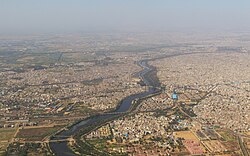| Sahibi River | |
|---|---|
 | |
| Location | |
| Country | India |
| Physical characteristics | |
| Source | |
| • location | Aravalli Range, From Jitgarh, Manoharpur, and Saiwar Protected Forest (PF) hills in Sikar District. |
| Mouth | |
• location | Delhi |
| Length | 120 km (75 mi) |
| Discharge | |
| • location | Yamuna in Delhi |
| Basin features | |
| Tributaries | |
| • left | Narayanpur Nala, Surakh Nali, Hajipur Nala, Kasoti Nala, Khar Nali |
| • right | Sota river, Kotkasim drain, Krishnavati river and Indori river (Indori Nallah), Dohan River |
| Waterbodies | Masani barrage, Najafgarh Lake |
| Bridges | Masani Bridge on NH-48, Sodawas Bridge on SH-14, Bridge onSH-52, Ajarka Bridge on Rewari-Alwar Railway Line, Pataudi Bridge on Rewari-Delhi Railway Line, Railway Bridge Nangal Pathani. |
The Sahibi river, also called the Sabi River, is an ephemeral, rain-fed river flowing through Rajasthan, Haryana (where its canalised portion is called the "Outfall Drain No 8") and Delhi states in India.[1] It originates in the eastern slopes of the Saiwar Protected Forest (PF) hills in Sikar District, enters Jaipur district near the foot of these hills, and after initially flowing southeast and east turns northeastwards near Shahpura and continues further till it exits Rajasthan to enter Haryana and further drains into Yamuna in Delhi, where its channeled course is also called the Najafgarh drain, which also serves as Najafgarh drain bird sanctuary. [2][3] It flows for 300 km of which 157 km is in Rajasthan 100 km is in Haryana and 40 km in Delhi.
The current and paleochannels of Sahibi river have several important wetlands that lie in series, including the Masani barrage wetland, Matanhail forest, Chhuchhakwas-Godhari, Khaparwas Wildlife Sanctuary, Bhindawas Wildlife Sanctuary, Outfall Drain Number 6 (canalised portion in Haryana of Sahibii river), Outfall Drain Number 8 (canalised portion in Haryana of Dohan river which is a tributary of Sahibi river), Sarbashirpur, Sultanpur National Park, Basai Wetland, Najafgarh lake and Najafgarh drain bird sanctuary, and The Lost lake of Gurugram, all of which are home to endangered and migratory birds, yet largely remain unprotected under extreme threat from the colonisers and builders.
Several Ochre Coloured Pottery culture sites (also identified as late Harappan phase of Indus Valley civilisation culture)[4] have been found along the banks of Sahibi river and its tributaries such as Krishnavati river, Dohan river (originates near Neem Ka Thana in Alwar district) and Sota River (merges with Sahibi river at Behror in Alwar district and its canalised portion in Haryana is called the "Outfall Drain No 6").[5] The drainage pattern for all these rivers is dendritic.
- ^ Cite error: The named reference
AKjainwas invoked but never defined (see the help page). - ^ Haryana rivers profile
- ^ Ropeway for tourist pull at barrage site, Times of India
- ^ Gupta, S.P., ed. (1995), The lost Sarasvati and the Indus Civilization, Jodhpur: Kusumanjali Prakashan
- ^ Cultural Contours of India: Dr. Satya Prakash Felicitation Volume, Vijai Shankar Śrivastava, 1981. ISBN 0391023586
© MMXXIII Rich X Search. We shall prevail. All rights reserved. Rich X Search
